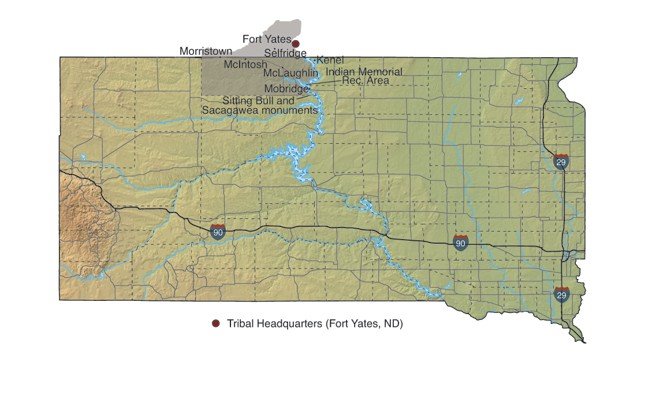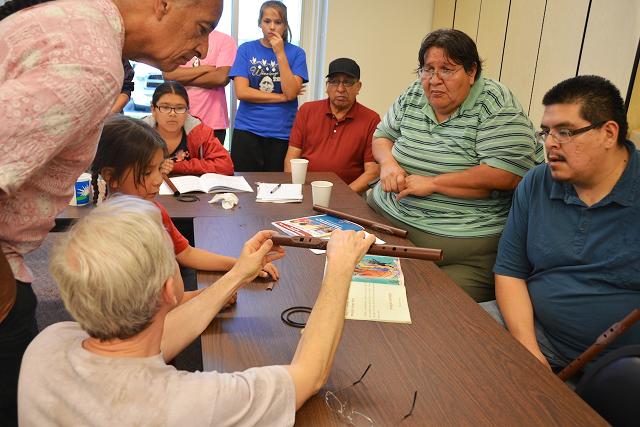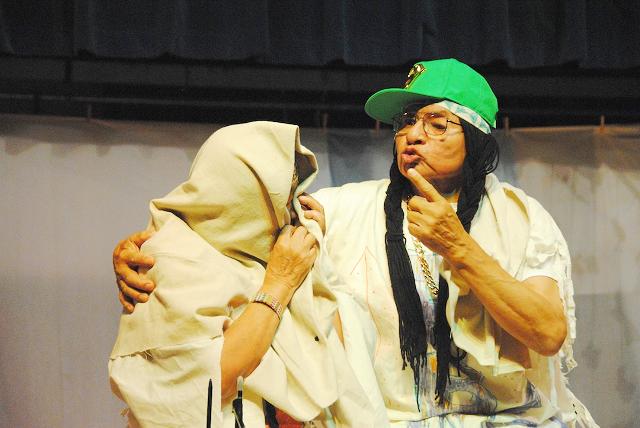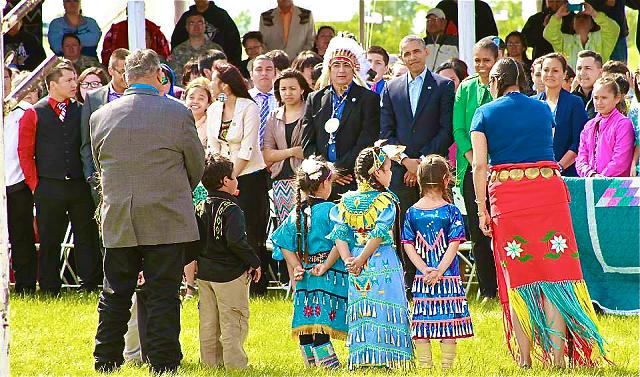 |
Canku Ota
|
 |
|
(Many Paths)
|
||
|
An Online Newsletter
Celebrating Native America
|
||
|
April 2015 - Volume
13 Number 4
|
||
|
|
||
|
Challenges And Solutions
To Keeping The Lakota Language Alive
|
||
|
by Christina Rose- Indian
Country Today Media Network
|
||
"There is more to an immersion school than simply bringing in elders and having them teach the chidren," said Sunshine Carlow, education manager of Lak?ól'iyapi Wahó?pifor, the Lakota Nest Immersion School on the Standing Rock Reservation in South Dakota. The challenges of opening, running and maintaining the small immersion school have been overwhelming, with costs limiting the amount of children the school can admit. "We have 10 kids in the nest and two cohorts," Carlow said. "The first cohort is in kindergarten right now, and this is their third year. We brought in the second cohort and we were going to do a third, but we didn't have the funding. We are operating on tuition, and right now we don't have the funds to hire another teacher." The Nest is currently using Go Fund Me to try to assure the school will continue. When the conversation about an immersion school began in 2011, fluent community members said they had learned Lakota by living with their grandparents. "But there is a big difference between having grandparents speaking to one or two children, and having an elder in the class with ten 3, 4, and 5 year olds. A big difference," Carlow laughed. "Out of respect, we are not going to put an elder in with ten kids."
Finding speakers to teach was one of the greatest challenges, and in a door-to-door survey, only about 30 speakers were qualified. Most of them had been active in the Lakota Summer Institute. The Lakota Summer Institute, or LSI, is an annual three-week language boot camp. Now entering its ninth year, the institute has taught Lakota to between 300 and 400 people. "We get almost all of the teachers from Pine Ridge, Cheyenne River, Standing Rock, Rosebud, and from other reservations and districts like Sioux Falls and Rapid City and Pierre, as well as Bismarck, Denver, Minneapolis, and from all over the country—and the world." Nicole Walker, education coordinator for the Standing Rock Sioux Tribe, said the Lakota Nest and the Lakota Summer Institute share a deep connection. "The last time the language was spoken by the majority was 40, 50, 60 years ago. At that point, the language was very much alive and people came up with new words everyday for the modern things we have now." Today, even fluent speakers don't spend enough time together for new words to evolve, so coming up with new words is one aspect of LSI. "Sometimes it's the really simple things that we take for granted, like foods or toys. How do we talk about playing with legos? So this is a time speakers can get together and hash it out," Walker said. The Neologism class, taught by Ben Black Bear, Sicangu, a first-language Lakota speaker, and the founder of the Lakota Studies program at Sinté Gleška University, is where lifelong Lakota speakers work together to develop new words. "All day we come up with new words, concepts, things that exist that we need words for," Black Bear said.
The class weighs new word ideas, and when they decide on one, they record it and pass it on to the community and schools. "If people accept it and start using it, we would put it in the dictionary, but only if it gains acceptance among the community." Many of these new words are brought back to the Nest, where they are incorporated with the language the students and teachers are learning. Black Bear, who also teaches at the Saint Francis School in Rosebud, said, "The Institute draws speakers of every level, from non-speakers just learning to people who are teaching the language but are not yet speakers. We usually get a lot of students who understand the language but don't speak it. To teach the lower levels, K-3, you don't have to be a good speaker, you can learn right along at that level. Right now, I am teaching third and fourth grade. We do follow the leader, stand up, walk forward, turn right, things like that. Anybody can learn if they have the interest and teach it while they are learning it, as long as they are trained teachers." Finding trained teachers is a problem that is addressed at LSI. Black Bear said, "We want to have teachers who can develop lessons, lesson plans and materials, so those are some of the courses they are learning at the summer institute." LSI teaches all levels, from Europeans to fluent Native speakers who come to learn the grammar, the writing system, sentence structure, phrases and common expressions, the sound system, spelling, and the writing system. "Even Native speakers whose first language is Lakota need to learn that stuff, just as people who grow up with English learn English in school; you learn to read or write. If we want to keep the language alive we have to teach fluent speakers the same thing," Black Bear said.
Wilhelm Meya, executive director of the Lakota Language Consortium, a partner of LSI and generator of the Lakota Dictionary and the Lakota Berenstain Bears program, said the summer institute began as a teacher training event and morphed into the leading place to learn Lakota. "We offer intensive Lakota courses that aren't offered anywhere else. It's an immersive atmosphere where you can take up to 6 hours a day over three weeks. It can really boost your fluency," he said. According to Black Bear, the Lakota language is healthier than it was five years ago. "It's growing leaps and bounds," he said. The Lakota Language Consortium has a language learning site and Facebook page where people can practice their language and receive corrections in their coursework. "I check my email everyday, and every day I am getting 20, 30, 50 people wanting to join the group. Every two or three days my email is full, so there is quite a bit of interest right now—and it is not just Lakota, it is growing worldwide." While it is growing among adults, there is still a shortage of children who are growing up speaking Lakota. Carlow said it's been 50 years since the elders heard the children speak Lakota. "We lose speakers every month and sometimes every week. We need to learn from then; when they go, what do we have? We have some children speakers now, but that's 10 children out of 3,500 people."
The Lakota Language Consortium co-sponsor LSI with the Standing Rock Sioux Tribe and Sitting Bull College, the host institution. Credits are received through college and students can receive a certificate or put credits towards a degree. "Language teachers have to be recertified. Part of that requirement is to have 6 credit hours of professional development every three to five years. The Standing Rock Tribe, which is one of the leading tribes working on language revitalization, has invested a lot of time, energy and money to ensure their students and tribal members have the most exposure and access to resources," Meya said. "It is modeled on the best summer institutes, both Native and other summer programs, so we have a strong pedagogical foundation." "It is such an inspiring three weeks, and after you survive that, it creates a very strong team," Meya said. "It's kind of the nexus of the movement, where people who have come for years have passed that activism on to the next group. It's an important aspect of bringing the language back, it inspires and empowers people and it keeps the teachers going until they come back the next year." |
||||||||||
 |
|
|
||
|
|
||
| Canku Ota is a free Newsletter celebrating Native America, its traditions and accomplishments . We do not provide subscriber or visitor names to anyone. Some articles presented in Canku Ota may contain copyright material. We have received appropriate permissions for republishing any articles. Material appearing here is distributed without profit or monetary gain to those who have expressed an interest. This is in accordance with Title 17 U.S.C. Section 107. | ||
|
Canku Ota is a copyright ©
2000 - 2015 of Vicki Williams Barry and Paul Barry.
|
||
 |
 |
|
|
The "Canku
Ota - A Newsletter Celebrating Native America" web site and
its design is the
|
||
|
Copyright ©
1999 - 2015 of Paul C. Barry.
|
||
|
All Rights Reserved.
|
||




